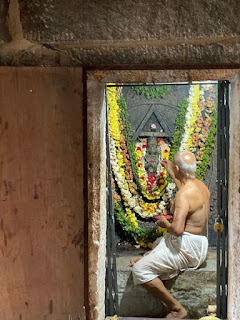Śrī Gaṇapati Atharvaśīrṣa, also known as the Gaṇapati Upaniṣad, was written by Atharva Ṛṣi. It is one of the main texts of the Gāṇapatya Saṃpradāya, a lineage adulating Gaṇeśa as the central divinity, thought to have become established in India from the 6th century onward. It is thought that a minimum of six groups of Gāṇapatyas (devotees of Gaṇeśa) existed, including one Tantric grouping centred on the worship of Ucchiṣṭa Gaṇapati [the Tantric form of Gaṇeśa], although relatively little is known about them.
The Gaṇeśa Upaniṣad belongs to a class of Vedic texts considered to be revelatory [śruti, ‘that which is heard’], and held to be without 'origin'. It is a manifestation of a particular 'Truth'.
Atharva Upaniṣad is not meant to be read, but to be recited.
The 7th verse of the Upaniṣad presents the Bīja or seed mantra of Gaṇeśa. The first perception of a mantra is held to arise from a human-divine contact of some kind; hence the first person to utter the mantra is known as its Gaṇaka [Seer (Sage)]. Here, the metre is ‘nichrat gāyatrī’, while the deity is Gaṇapati.
The aim of this write-up is to simplify the mantra to people who are unfamiliar with the terminology. In no way do I attempt to claim that the information I am offering is an exact translation of the verse. Please forgive any errors.
ga̱ṇādi̎ṃ pūrva̍muccā̱rya̱ va̱rṇādi̎ṃ
tadana̱ntaram anusvāraḥ
pa̍rata̱raḥ ardhe̎ndula̱sitamtāre̍ṇ
hṛ̱ddham etattava manu̍svarū̱pamgakāraḥ
pū̎rva rū̱pamakāro madhya̍m
rū̱pamanusvāraścā̎ntya
rū̱pambindurutta̍rarū̱pamnāda̍ḥ
sandhā̱nam sagͫhi̍tā sa̱ndhiḥ
saiṣā gaṇe̍śavi̱dyā gaṇa̍ka ṛ̱ṣiḥ
nicṛdgāya̍trīccha̱ndaḥ gaṇapati̍rdeva̱tā
oṃ ‘GUNG’ [GAṂ | GAṆAṂ | GAṆAUṂ | GUṂ] ga̱ṇapa̍taye namaḥ || 7||
The letter ‘GA’ is to be enunciated, followed by ‘ṆA’. This one-word mantra is then potentiated with the ‘PRAṆAVA’ ‘OṂ’. ‘GA’ is the first part, ‘ṆA’ is the middle-part, and the end is ‘UṂ’, automatically formed in this conjunction with the bindu (or anusvara, ं). The sacred mantra is formed by these three letters.
If pronounced properly, this mantra has the power of revealing the Divine Lord Gaṇeśa.
OṂ ‘GUNG’ GAṆAPATI | My salutation to you. [inferring that the devotees should bow to the Lord].
Let us now peruse notes from the Varadā Tantra [Tantric text]:
“GA, I speak unto Thee, means ‘Gaṇeśa’. Bindu means the dispeller of sorrow.
Thus, O Maheśvarī, the meaning of the Gaṃ-bīja is spoken to Thee out of love for Thee.”
Gaṃ is uttered, prefixed with Oṃ. The Bindu is the essence (i.e. higher form) of all sounds. The Nāda (Cosmic Sound) is the utterance [of the mantra]. ‘Joining together’ refers to the unification of deity and devotee through the letter recitation of the seed-mantra, which is the essence thought-form of the God.
The terms ‘Bindu’ and ‘Nāda’ represent two particular stages in the process of the manifestation of Śakti. Bindu is generally understood as a 'point'. ‘Nāda’ is etymologically derived from 'sound'. Śakti moves from Nāda to Bindu. Nāda is the maithuna (congress) or yoga of Śiva-Śakti, which in turn produces the bindu, which again differentiates into threefold aspects, although in denser form.
NOTE ON PRONOUNCIATION
‘Oṃ Gung Gaṇapataye Namaḥ’ is the Bīja Mantra of Lord Gaṇeśa. Additionally, recall that ‘Oṃ Gaṃ Gaṇapataye Namaḥ’ is another Gaṇeśa Mantra. The fruits of both these mantras are different. The ‘Gung’ in the first mantra is to be pronounced as ‘Sung’.
There is confusion around the pronunciation of the root word ‘GAṂ / GUNG’. Many pronounce it as ‘gan’, some as 'gaṃ / guṃ' and some as ‘gung’.
If we carefully dissect the terminology, we can understand the word to be composed of:
GA + NA +AUṂ.
Following Sanskrit laws of grammar, the word comes to be ‘Ganauṃ’, which can be pronounced as ‘ga un a uṃ’. With practice, it may sound as ‘Gaṃ / Gung / Ganaṃ / Guṃ’, but it will mostly sound as ‘GAṂ’.
The emphasis here specifically is to clearly pronounce the word with nāda [resonance], and with laya [rhythm]. Although some may argue that the ‘ang’ in Gung is not apparent, through the phonetics emergent from nāda and laya, pronouncing Gaṃ / Ganauṃ does sound like ‘Gung’.
The practice of recitation can be learnt from a master if one is fortunate enough to encounter a genuine one.
JAPA, or recitation, is the spiritual practice of devotedly repeating a mantra, for what generally is a specific number of times such as 108, often while counting each recitation on beads tied in a strand known as the japa mālā. This is done while one conscientiously concentrates on the meaning of the mantra they are reciting. The repetition should be dutifully slow.
Highlighting the significance of japam, Lord Kṛṣṇa decrees in the Bhagavadgītā:
Of all the Vedas, I am the Sāmaveda.
Of all the Yajñas, I am the japa yajña.
The repetition of positive, uplifting, spiritual mantras over and over again lifts consciousness and causes the mūlādhāra cakra to spin clockwise.
There are three ways by which one can do japam:
1. Ucchahi, or loud recitation, which is less effective.
2. Upāṃśu, or soft recitation, which is more effective.
3. Mānasikaṃ, or internal japa, ‘within the mind’, which is most effective.
AUṂ GAṂ GAṆAPATYE NAMAḤ.








